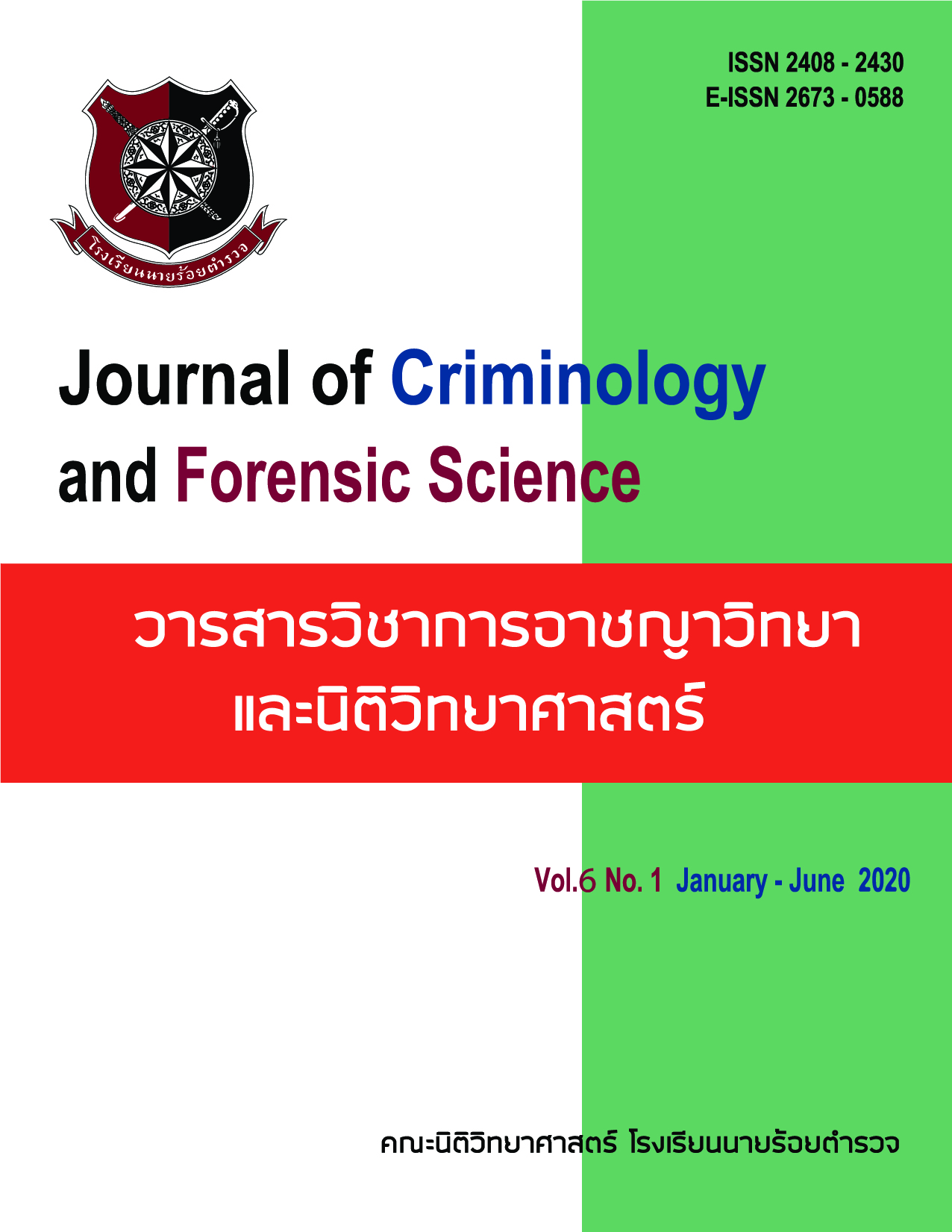ความสัมพันธ์ระหว่างอาชญากรรมยาเสพติดและอาชญากรรมเกี่ยวกับทรัพย์
Main Article Content
บทคัดย่อ
งานวิจัยนี้มีวัตถุประสงค์เพื่อศึกษาความสัมพันธ์ระหว่างอาชญากรรมยาเสพติดและนโยบายการปราบปรามยาเสพติดที่ส่งผลต่ออาชญากรรมเกี่ยวกับทรัพย์ โดยตั้งสมมติฐานไว้ 2 รูปแบบ คือ การเสพยาเสพติดก่อให้เกิดอาชญากรรมเกี่ยวกับทรัพย์ หรือในอีกมุมหนึ่งการป้องกันและปราบปรามอาชญากรรมหนึ่งที่เพิ่มขึ้น อาจกระตุ้นให้เกิดการก่ออาชญากรรมอื่นขึ้นได้ และสมมติฐานว่าการปราบปรามยาเสพติดอาจก่อให้เกิดอาชญากรรมเกี่ยวกับทรัพย์ ผู้วิจัยได้ใช้รูปแบบทางเศรษฐศาสตร์ของอาชญากรรม
ในการศึกษาความสัมพันธ์ทางสถิติระหว่างคดีประทุษร้ายต่อทรัพย์และตัวกำหนดอาชญากรรมที่เกี่ยวข้องกับอาชญากรรมยาเสพติด รวมถึงปัจจัยทางเศรษฐกิจและสังคม ทำการวิเคราะห์โดยใช้วิธีประมาณค่า Two-Stage Least Square (TSLS) โดยการรวบรวมข้อมูลภาคตัดขวาง (Panel Data) จำนวน 77 จังหวัด ในประเทศไทย ตั้งแต่ปี พ.ศ. 2549 – 2558
จากผลการคาดประมาณโดยสมการตัวกำหนดคดีประทุษร้ายต่อทรัพย์ในแบบจำลองที่ 1 พบว่า ขนาดตลาดยาเสพติดมีผลทำให้เกิดอัตราคดีประทุษร้ายต่อทรัพย์ลดลง ปฏิเสธสมมติฐานที่ว่ายาเสพติดก่อให้เกิดอาชญากรรมเกี่ยวกับทรัพย์ อีกทั้งพบว่าเมื่อมีความเป็นไปได้ในการจับกุมคดีประทุษร้ายต่อทรัพย์เพิ่มขึ้น อัตราการเกิดคดีประทุษร้ายต่อทรัพย์จะลดลง และเมื่อรายได้เฉลี่ยต่อหัวของประชากรเพิ่มขึ้น มีผลทำให้คดีประทุษร้ายต่อทรัพย์ลดลงด้วย แต่เมื่อผลิตภัณฑ์มวลรวมจังหวัดเพิ่มขึ้นจะทำให้
เกิดคดีประทุษร้ายต่อทรัพย์เพิ่มขึ้น เป็นไปตามสมมติฐานและทฤษฎีเศรษฐศาสตร์อาชญากรรม ทั้งนี้ เมื่อสัดส่วนของประชากรชายเพิ่มขึ้นจะทำให้การเกิดคดีประทุษร้ายต่อทรัพย์ลดลงไปด้วย
ผลการทดสอบในแบบจำลองที่ 2 พบส่วนที่สำคัญ คือ การจับกุมผู้กระทำผิดตามกฎหมายเกี่ยวกับยาเสพติดส่งผลให้ความเป็นไปได้ในการจับกุมคดีประทุษร้ายต่อทรัพย์ลดลง สอดคล้องกับสมมติฐานว่าการปราบปรามยาเสพติดเป็นสาเหตุหนึ่งของการเกิดอาชญากรรมเกี่ยวกับทรัพย์ และสนับสนุนผลจากแบบจำลองที่ 1 เนื่องจากหากผู้กระทำผิดและผู้เสพยาเป็นกลุ่มเดียวกันแล้ว การจับกุมการกระทำผิดตามกฎหมายเกี่ยวกับยาเสพติดและความเป็นไปได้ในการจับกุมคดีประทุษร้ายต่อทรัพย์ควรมีความสัมพันธ์
ในทิศทางเดียวกัน อีกทั้งยังพบว่าสัดส่วนคนยากจนมีผลทำให้ความเป็นไปได้ในการจับกุมคดีประทุษร้ายต่อทรัพย์เพิ่มขึ้น แต่เมื่องบประมาณของสำนักงานตำรวจแห่งชาติ (สตช.) เพิ่มขึ้น จะส่งผลในทางตรงข้าม
จากผลการคาดประมาณสมการตัวกำหนดงบประมาณ สตช. ในแบบจำลองที่ 3 พบว่า งบประมาณ สำนักงานตำรวจแห่งชาติ แปรตามอัตราการเกิดคดีประทุษร้ายต่อทรัพย์และจำนวนประชากร อย่างไรก็ตาม ตัวแปรขนาดตลาดยาเสพติดมีความสัมพันธ์แบบผกผันกับงบประมาณสำนักงานตำรวจแห่งชาติ ซึ่งไม่เป็นไปตามสมมติฐานที่ตั้งไว้
Article Details
เนื้อหาและข้อมูลในบทความที่ลงตีพิมพ์ใน วารสารวิชาการอาชญาวิทยาและนิติวิทยาศาสตร์ โรงเรียนนายร้อยตำรวจ ถิอว่าเป็นข้อคิดเห็นและความรั้บผิดชอบของผู้เขียนบทความโดยตรงซึ่งกองบรรณาธิการวารสาร ไม่จำเป็นต้องเห็นด้วยหรือรับผิดชอบใดๆ
บทความ ข้อมูล เนื้อหา รูปภาพ ฯลฯ ที่ได้รับการตีพิมพ์ใน วารสารวิชาการอาชญาวิทยาและนิติวิทยาศาสตร์ ถือว่าเป็นลิขสิทธิ์ของวารสาร วารสารวิชาการอาชญาวิทยาและนิติวิทยาศาสตร์ หากบุคคลหรือหน่วยงานใดต้องการนำทั้งหมดหรือส่วนหนึ่งส่วนใดไปเผยแพร่ต่อหรือเพื่อกระทำการใดๆ จะต้องได้รับอนุญาตเป็นลายลักษณ์อักษรจาก วารสารวิชาการอาชญาวิทยาและนิติวิทยาศาสตร์ ก่อนเท่านั้น
เอกสารอ้างอิง
Becker, G. S. (1968). Crime and Punishment: An Economic Approach. Journal of Political Economy, 76(2), 169–217.
Bennett, T. (2000). Drugs and Crime: The Results of the Second Developmental Stage of the New-Adam Programme, Home Office Research Study 205. London: Institute of Criminology, University of Cambridge.
Benson, B., Kim, I., Rasmussen, D., and Zuehlke, T. (1992). Is Property Crime Caused by Drug Use or by Drug Enforcement Policy. Applied Economics, 24(7), 679–692.
Benson, B., and Rasmussen, D. (1991). The Relationship Between Illicit Drug Enforcement Policy and Property Crime. Contemporary Economic Policy, 9(4), 106–115.
Chitsawang, N. (2011). Drug and Crime: Literature Review Part 2. Retrieved September 27, 2017. from https://www.Gotoknow.Org/Posts/411418. (In Thai).
Chokprajakchat, S. et al. (2017). Analysis of the Decriminalization In the Development of Thai Policy On Drug. Parichart Journal, 30(2), 295-320. (In Thai).
Goldstein, P. (1985). The Drugs/Violence Nexus: A Tripartite Conceptual Framework. Journal of Drug Issues, 15(4), 493–506.
Kanazawa, S., and Still, M. (2000). Why Men Commit Crimes (and Why They Desist). Sociological Theory, 18(3), 434 – 447.
Miron, J., and Zwiebel, J. (1995). The Economic Case Against Drug Prohibition. Journal of Economic Perspectives, 9(4), 175–192.
Morgan, J.P. (1991). Prohibition is Perverse Policy: What Was True in 1933 Is True Now. In Searching For Alternatives: Drug-Control Policy in the United States. Stanford: Hoover Institution Press.
Nilsson, A., and Agell, J. (2003). Crime, Unemployment and Labor Market Programs in Turbulent Times. Institute for Evaluation of Labour Market and Education Policy, Uppsala. 2013(14), 1-26
Royal Thai Police. (2017). Information on Reports of Crimes Against Property, Compared with Narcotic Act B.E. 2522. Retrieved September 27, 2017. from http://Service.Nso.Go.Th/Nso/Web/Statseries/Statseries13.Html. (In Thai).
Uaamnoey, J. (2008). Sociology of Crime. Bangkok: Chulalongkorn University. (In Thai).
Yodmanee, C. et al. (1991). The Relation Between Drug use and Committing Crime. Bangkok: Office of The Narcotics Control Board. (In Thai).


